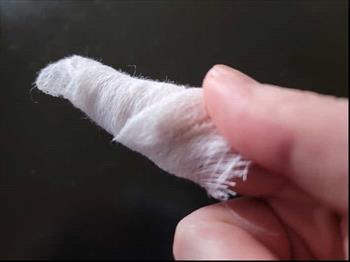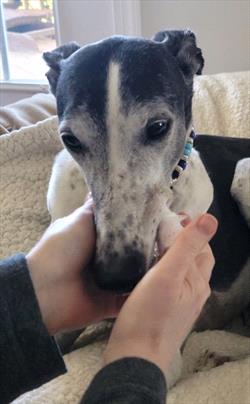
Photo courtesy of Sherrie Yuschak, RVT, VTS (Behavior), KPA-CTP
Dental disease is painful and most pets over the age of three suffer from gum disease. Recommended by veterinarians, daily toothbrushing is one of the best ways to slow the progression of dental disease, lengthen the time between professional cleanings, and has many other benefits to your pet’s overall health. For some pets, a toothbrush is scary and, for many pet owners, hard to maneuver in the mouth making brushing a chore. Be aware that if your pet has dental disease, brushing with your finger may cause pain and use caution not to get bitten.
How can we make brushing less of a chore and more fun for all?
The answer: 3”x3” cotton gauze squares
Gauze is more abrasive and effective than rubber finger brushes and less invasive than a brush with a handle. Gauze allows you to feel when you’re touching the teeth instead of the delicate gums. Check with your veterinarian and stop brushing immediately if your pet seems painful or bleeding occurs.
Choosing the Toothpaste:
When brushing teeth, it is important to choose a toothpaste specifically designed for pets and approved by the VOHC (Veterinary Oral Health Council). Avoid human toothpaste since some contain Xylitol which is toxic to pets. From the many flavors available, find one your pet likes best. If your pet is still resistant, start the training process with tuna juice or gravy to help create a strong positive association with brushing.
Low Stress Handling

Photo courtesy of Sherrie Yuschak, RVT, VTS (Behavior), KPA-CTP
Let’s start brushing!
Step 1: Unfold the gauze square and wrap it around your index finger. Pinch the tail of the gauze with your thumb.
Step 2: Dip your fingertip into the juice or gravy or place a pea-sized dot of pet toothpaste on your fingertip and allow your pet to lick your fingertip. Repeat three times. Your pet should quickly and eagerly approach and lick your finger before you move to the next step.
Step 3: Repeat steps 1-3 and slide your finger under your pet’s upper lip and make a gentle brief brush action. Then allow them to lick the remaining toothpaste. Repeat three times. Your pet should approach and not back away from your finger. Avoid restraining your pet’s head or following them if they move their head away. Repeat until your pet is holding still and eagerly licking the toothpaste.
Step 4: Repeat the above steps and place your finger farther towards the top back teeth. Gradually increase the gentle brushing swipes then allow your pet to lick the remaining toothpaste. You can place your hand under their chin to steady their head if necessary.
Step 5: Repeat the above technique to brush the outside of the lower teeth on the same side.
Step 6: Wrap a new piece of gauze around your finger to regain abrasiveness, apply more toothpaste and brush the top and bottom teeth on the other side of the mouth. Your pet’s mouth is now healthier!
Remember:
When you brush your pet’s teeth it’s okay if you aren’t perfect. It is more important for your pet to be comfortable and willing to accept frequent brushing. Strive for brushing every day. Set yourself up for success by placing your pet’s toothpaste where you will incorporate it into your daily routine.
Spend a little bit of time teaching your pet to enjoy toothbrushing for positive results. Your pet’s health will improve, your veterinarian will be pleased you’re being proactive, and you can save money by decreasing the frequency and intensity of professional dental cleanings.